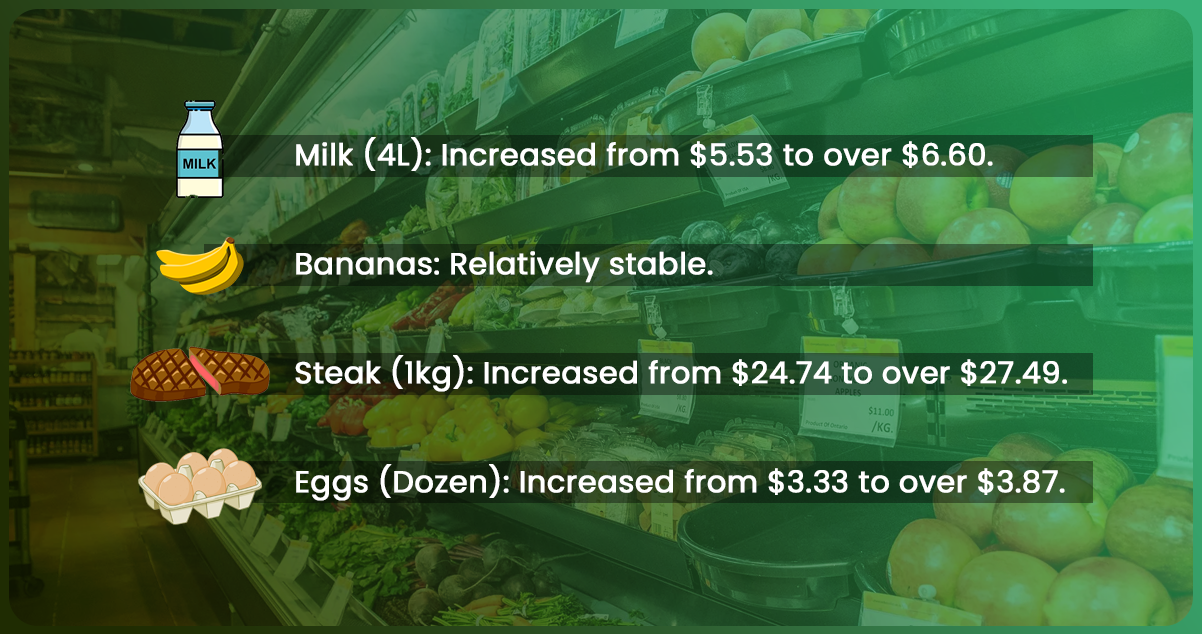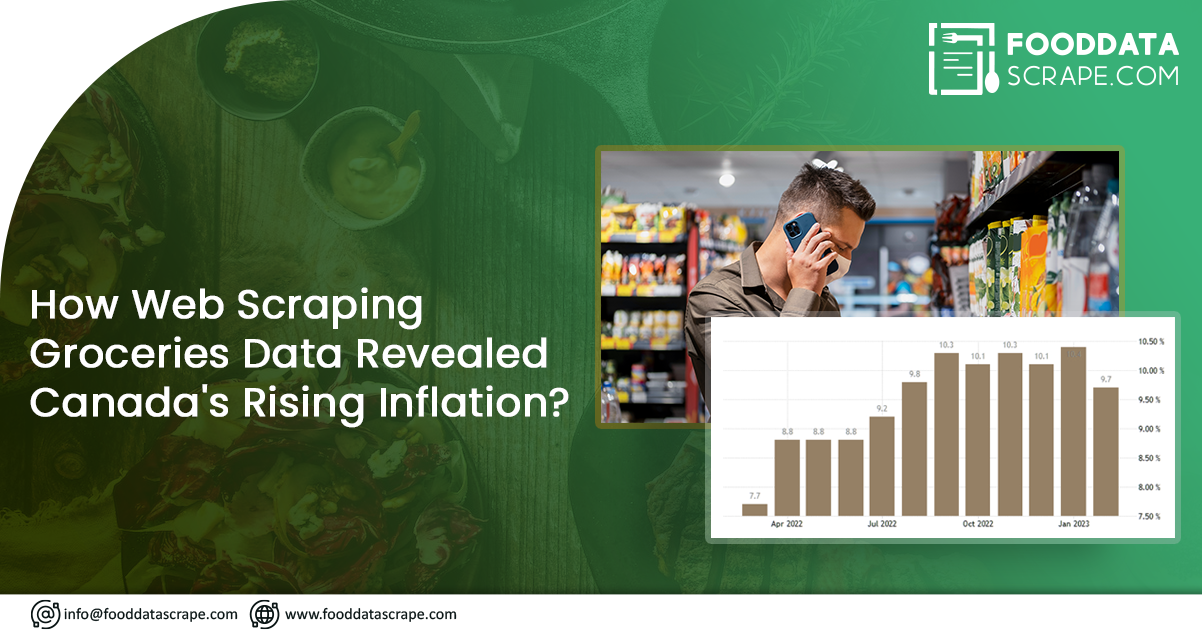The escalating cost of grocery shopping in Canada has become a cause for concern as inflationary trends continue to impact everyday items. The voices of frustrated shoppers echo nationwide, with evident reflecting in search queries like "Canadian grocery inflation" on platforms like Google. The gravity of this matter has captured the attention of Canadians, and the issue will persist in the foreseeable future.
In this blog post, we will delve into grocery prices in Canada by utilizing Grocery Pricing Data Intelligence. By analyzing this data, we can gain insights into the country's grocery and food inflation. Additionally, we will explore potential factors contributing to these price increases, propose solutions, and discuss the long-term implications for Canadian households.
Loblaws recently faced criticism when selling chicken breast at a significantly higher price than other major competitors, with a price tag of nearly $40 Canadian for a pack. Surprisingly, this was not a pricing error, as the price was accurate.
Several factors could contribute to the rising cost of groceries in Canada. Here are some possible reasons:
Inflation: Inflation refers to the general increase in prices over time. If the overall price level in the economy is rising, it can also lead to higher costs for groceries.
Supply Chain Disruptions: Disruptions in the global supply chain can impact the availability and cost of goods, including groceries. Events such as natural disasters, trade disputes, or pandemics (like the COVID-19 pandemic) can disrupt the flow of goods and increase costs.
Transportation Costs: Rising fuel prices or changes in transportation costs can affect the prices of groceries. Increasing transportation costs can lead to higher prices for imported goods or products that require long-distance transportation.
Exchange Rates: Fluctuations in currency exchange rates can affect the cost of imported goods. If the Canadian dollar weakens against other currencies, it can increase imported groceries costs.
Weather Conditions: Extreme weather events, such as droughts, floods, or storms, can impact agricultural production. If crops are damaged or yields are lower, it can lead to reduced supply and higher prices for specific food items.
Increased Demand: Changes in consumer behavior or shifts in population demographics can increase demand for certain groceries. If demand outpaces supply, it can lead to higher prices.
Labor Costs: If labor costs increase, such as minimum wage hikes or changes in labor regulations, it can affect the production and distribution costs of groceries, which directly passes to consumers.
How Can Web Scraping Reveal Inflation of Rising Grocery in Canada?

Web scraping grocery data can provide valuable information on the pricing and availability of grocery items from various online sources, such as grocery store websites, e-commerce platforms, and price comparison websites. By collecting data on the prices of specific grocery items over time, web scraping can help reveal inflation patterns and track the rising cost of groceries. By leveraging web scraping techniques to collect and analyze pricing data from various online sources, it becomes possible to monitor and assess the inflation of rising grocery prices in Canada. This approach provides valuable insights into the current state of grocery inflation, helping consumers, researchers, and policymakers make informed decisions.
Scrape grocery data to reveal inflation in rising grocery prices in Canada through the following steps:
- Identifying Target Websites: : Determine the relevant websites that provide information on grocery prices in Canada. It can include online grocery retailers, supermarket websites, price comparison platforms, or other sources displaying pricing information.
- Defining Scraping Parameters: Specify the specific data points to extract, such as product names, prices, dates, and other relevant details. Customize the scraping process to target the necessary elements on the web pages.
- Automating Data Collection: Utilize grocery data scraping tool to automate the data collection. It involves writing code that navigates through the target websites, extracts the desired information, and saves it in a structured format (e.g., CSV or database).
- Regular Data Updates: Set up a regular scraping schedule to Scrape On-Demand Grocery Delivery Data at consistent intervals. It ensures that you have a historical record of prices over time, allowing you to track inflationary trends.
- Data Analysis: Once you have accumulated a substantial dataset using a grocery data scraper, analyze data to identify patterns and trends. Calculate price changes, inflation rates, or average price indexes to quantify the inflation of grocery prices in Canada.
- Comparison Across Sources: Compare prices across websites or retailers to identify variations and discrepancies. It can provide insights into how different grocery items are affected by inflation and help assess the overall impact on consumers.
- Visualize and Report Findings: Present the scraped data and analysis in visual formats such as charts, graphs, or tables. It enables clear communication of the inflationary trends in grocery prices to stakeholders, policymakers, or the general public.
How did Food Data Scrape Reveal Inflation?

Using Food Data Scrape, it becomes feasible to aggregate data from multiple sources, including supermarkets, and export it on a scheduled basis. The data is saved in formats like CSV or JSON files or accessed through the API for analysis. Many businesses rely on us for price monitoring, enabling them to discover average cost inflations for different food products or identify regional disparities in price hikes. With extensive food pricing data, shoppers can make more informed decisions, while policymakers can devise targeted measures to address underlying economic inflationary issues.
By extracting data from various websites using grocery data scraping services, particularly grocery store sites across Canada, it becomes possible to uncover patterns in grocery costs, providing more precise insights into inflation rates. Historical pricing data is available from digital flyers, statistical websites, or analytic platforms.
Here are some examples of average food and grocery prices in Canada from 2015 to 2023:
- Milk (4L): Increased from $5.53 to over $6.60.
- Bananas: Relatively stable.
- Steak (1kg): Increased from $24.74 to over $27.49.
- Eggs (Dozen): Increased from $3.33 to over $3.87.
- According to Trading Economics, the cost of food and non-alcoholic beverages witnessed a 9.7% increase in February 2023, slightly lower than the 10.4% increase in the previous month.
- Delivery Information
- Operating Hours
- Contact Details
- Images
- Payment Options
- Customers Testimonials
- Offers and Discounts
However, Grocery Delivery Scraping API Services, coupled with Statistics Canada data, enables tracking price fluctuations and their comparison to past trends, offering a better understanding of the factors driving grocery inflation. Data analysis allows for precautionary decision-making to mitigate significant price increases.
Artificial intelligence (AI) and machine learning algorithms, combined with web scraping and data analysis, can optimize supply chain management and streamline logistics. By enhancing efficiency and reducing waste, these advanced technologies contribute to cost reduction and lower prices for consumers.
Web scraping can also monitor the effectiveness of such algorithms, tracking adoption rates and their impact on grocery prices. Governments and corporations can leverage collected data to choose strategies that effectively curb inflation, enabling better policy-making and pricing decisions for the benefit of society.
Conclusion: Canadian grocery inflation poses a significant challenge for families nationwide. Nevertheless, web scraping offers a valuable tool for gaining deeper insights into the factors driving price increases and seeking potential solutions. As technology advances, innovative methods in food production and supply chain management hold promise for mitigating the impact of inflation on shoppers.
By leveraging web scraping, data analytics, and statistical analysis, we can continue monitoring the rising grocery costs in Canada and globally. With collaborative efforts, we can work towards addressing the escalating food prices before they become unaffordable for many.
For further details, contact Food Data Scrape now! You can also reach us for all your Food Data Aggregator and Mobile Restaurant App Scraping service requirements.
























































































